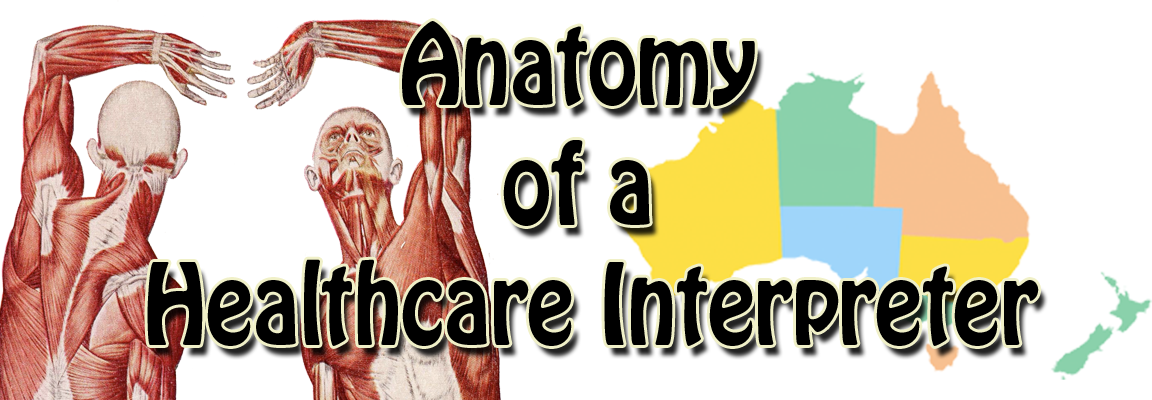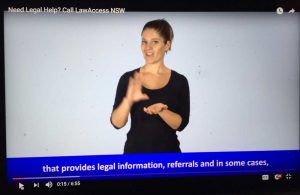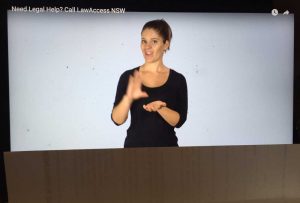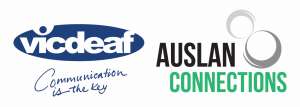
24 January 2017
Victorian Deaf Education Institute
Melbourne, Australia
In the United States, the National Consortium of Interpreter Education Centers (NCIEC) identified health care as one of the areas where Deaf people the most challenges in finding qualified interpreters. This workshop will explore what it takes to provided quality services in healthcare settings. Using the framework of the NCIEC’s Domains & Competencies as well as the healthcare interpreting professional lattice, we will explore resources that support professional development in medical settings.
Workshop Presentation & Handout
Click the buttons below to download resources for the presentation.
View Presentation Slides Download Handout
Remote Participants: If you are viewing live stream, you might want to have the stream of the discussion in one window and be able to view the presentation slides in another. I will give you cues as to what slide I am on so you can follow along.
Workshop Resources
Workshop Resources
Each of the titles in the list below is a link. When you click on the title, it will reveal a series of resources contained in that category.
"Anatomy of Healthcare Interpreter" Resources
Case-Conferencing Articles
Here are a list of articles that touch on the importance of Case-Conferencing:
Posted in: "Anatomy of Healthcare Interpreter" Resources, "Anatomy of Medical Interpreter" Resources, "Exploring Emerging Paradigms" Resources, "Finding Your Place" Resources, Case Conferencing Resources, Mentoring Resources
CATIE Center Resources

The CATIE Center at St. Catherine University is a part of the National Consortium of Interpreter Education Centers. It has been a part of producing a number of resources for interpreting in health care settings.
- Domains and Competences for Healthcare Interpreting: This document identifies the broad domains and individual competencies needed for effectively working in healthcare settings.
- Annotated Bibliography: This resource identifies relevant resources and articles/books and suggests which domains they apply to. It is available in a variety of formats, including a spreadsheet that is searchable.
- Towards Reflective Practice: This document developed by Karen Malcolm uses the framework of the Demand Control Schema from Robyn Dean and Bob Pollard to help interpreters work toward being more reflective in their practice.
- Body Language Workshops: These workshops provide a focus on developing language for talking about anatomy and medical procedures.
- Healthcare Interpreting Career Lattice: The Healthcare Interpreting Career Lattice provides an outline of what is needed to enter this specialty, and identifies specific steps towards developing competency.
- Videos available on Healthcareinterpreting.org
Posted in: "Anatomy of Healthcare Interpreter" Resources, "Anatomy of Medical Interpreter" Resources
Demand-Control Schema
Publications
The work by Robyn Dean and Robert Pollard has facilitated a fundamental shift in the interpreting profession from a deontological sense of ethics to a more teleological one. If you are curious about what that means, check out their web site at: Demand-Control Schema
From their web site, you can contact Robyn Dean for the latest information. It is important to recognize that understandings of the Demand-Control Schema is not static. Dean & Pollard are continuing to refine the application of DC-S so be sure to look for the most up-to-date publications and materials.
The latest article from Dean and Pollard which contains the most updated formulation of the Demand-Control Schema in an article format.
Dean & Pollard, 2012. Context-based Ethical Reasoning in Interpreting: A Demand Control Schema Perspective. The Interpreter and Translator Trainer, 5(1) 2011, 155-82.
You can access more of Dean’s publications here.
Webinars & Videos
MARIE Center Webinars
Robyn Dean did a series of webinars in 2014 for the MARIE Center as part of the NCIEC. These are presented in spoken English with captioning and ASL interpretation.
Videos as Part of NCIEC Mentoring Toolkit
Robyn Dean and Bob Pollard created a series of ASL videos explaining the Demand-Control Schema. (These are created in ASL without any English translation.) See those videos under the heading “Robyn Dean.”
Additional Resources
Facebook: get updated information here.
Observation-Supervision: Here’s a blog post from Robyn Dean about the important of developing these groups for observation-supervision.
 Text Book: In 2013, Robyn Dean and Robert Pollard published a textbook on Demand-Control Schema. You can order a copy here.
Text Book: In 2013, Robyn Dean and Robert Pollard published a textbook on Demand-Control Schema. You can order a copy here.
A Resource on Tacit Schemas for Ethical Decision-Making
Rest, J.R., Navarez, D., Bebeau, M., and Thoma, S.J. (1999). Postconventional moral thinking: A neo-Kohlbergian approach. Mahwah, NJ: Lawrence Erlbaum Associates.
Posted in: "Anatomy of Healthcare Interpreter" Resources, "Anatomy of Medical Interpreter" Resources, "Exploring Emerging Paradigms" Resources, "Finding Your Place" Resources, "Part of the Team" Resources, "TIPS-Light" Resources, "Turning on the Light" Resources, Case Conferencing Resources, Emerging Paradigm Resources, In Service to Literacy, Mentoring Resources, Moving toward Best Practice, Putting Theory into Practice, Sense of Place, Swiss Army Knife Tools, Wisconsin Ed Summit, Workshop Resources
Auslan-Specific Resources
These resources related specifically to Auslan and interpreting in Australia were developed with support from ASLIA-Victoria and vicdeaf and Sign Language Video Productions. Thanks for their support in helping to create new professional development resources.
Auslan Resources
Auslan Videos with English translations
AUSLAN Resources with English Translations
This page contains both some suggestions for how to work with AUSLAN videos with English translations – as well a list of texts that can be used in this way. Scroll down for links to videos.
Possible Activities:
Working from AUSLAN to English:
- Interpret the video with sound off and blocking captions. It is most helpful if you can record your interpretation to review and reflect on – as well as to compare to the original translation in the next step.To block the captions, simply fold up a sheet of paper and lean it against your computer monitor. Here’s an example:
Original Video

After Covering Captions

- Listen to the original translation or read the captioned English version. Compare this source to your interpretation in step 1. Note the areas that you were on target as well as the places where your interpretation diverged. What was happening in the video at those points? Does that fit with any patterns that you see in your work?
- Re-Interpret the video with the sound off and captions blocked. Try to incorporate what you learned from Step 2 in your new interpretation. (This is not cheating. This is an opportunity to practice fluency in our work.)
Working from English to AUSLAN:
- Interpret from English to AUSLAN: Listen to the English translation of the video, but don’t watch the AUSLAN version. Interpret this into AUSLAN. Again, it is best to record yourself to assist in analysis and reflection.
- Watch the original AUSLAN version. Compare this source to your interpretation in step 1. Note the areas that you were on target as well as the places where your interpretation diverged. What was happening in the video at those points? Does that fit with any patterns that you see in your work?
- Re-Interpret again using the English translation as source. Try to incorporate what you learned from Step 2 in your new interpretation. (This is not cheating. This is an opportunity to practice fluency in our work.)
The links below have a variety of topics explained in Auslan, with captioning and English translations. Videos formatted in this way are excellent opportunities to practice interpreting in a variety of ways.
These videos were created to be a part of workshops delivered by Doug in Australia
Source without Captions
Original Video (with English captions)
A Visit to Gallaudet
Thanks to Sherrie Beaver for her willingness to share this video. You can see more from Sherrie on her Facebook page, I Sign I Wander.
Visit to Gallaudet – English Translation
This translation was created by Jen Blyth. It is not designed to be the exemplary way to translate the source text, but one approach to be used as a resource for considering how you can create a more effective interpretation than your first attempt.
I am at Gallaudet University, wow, it is beautiful. Me and my friend Pip have had a tour of this university, and it is really beautiful. There is so much history here. Gallaudet is now 152 years old, so much history. I had a look at the buildings and met Gallaudet’s President, Bobbi, I forgot her last name. It was nice to meet her finally, she was a nice woman, we met coincidentally. We also saw the Deaf Space, wow, such an amazing concept. So much history, so many stories. We met an old man who told us about his experience at Gallaudet twenty or forty years ago. While on our tour we saw so many Deaf people around, socialising and talking. This is truly a Deaf space – a ‘Deaf Mecca’, truly wonderful. I always envisioned studying here one day, but I need money! Perhaps I should go to the bank or marry an American person! Look behind me…
A Visit to Gallaudet – Slow Motion
The video has been slowed down to provide a better opportunity for analysis and practice. (It is 80% speed of original video.)
Resources from the Deaf Society New South Wales
These video resources were created to share information in the Deaf community. Because they are formatted with both AUSLAN and English versions, they allow for interpreter skill development similar to practiced in the workshops.
http://deafsocietynsw.org.au/auslan_resources
Posted in: Auslan Resources
Storytelling Resources: AUSLAN – English
Fairytales from Auslan Storybooks
- Goldilocks and the Three Bears
- The Three Little Pigs
- Little Red Riding Hood
- The Gingerbread Man | Aussie Version
- Cinderella
Spoken English Versions
You can use these as a source text if you want to practice from English to AUSLAN – working to incorporate what you saw in the storytelling from Auslan Storybooks.
- Goldilocks and the Three Bears | Another version
- The Three Little Pigs
- Little Red Riding Hood
- The Gingerbread Man
- Cinderella
Posted in: Auslan Resources
Discourse Mapping – Auslan
This series of videos is designed to both learn about the features of discourse mapping and practice incorporating them in your work.
A Lesson on Weather and Climate in Australia
The video above was captioned for accessibility. The original video is at: https://youtu.be/QHn8YGdApOs
Lesson Plan for This Video
Objectives: Successful students will be able to:
- Identify the difference between weather and climate
- Compare and contrast Tropical and Temperate climate zones
- Explain the difference between weather and climate at Uluru in central Australia.


Example Video without Discourse Mapping
This video was created with an attempt to not have discourse mapping feature – which is a significant challenge.
Example Video with Discourse Mapping
This video was created with a more complete range of discourse mapping features.
Year 11 Lecture on Anatomy of a Neuron
You can see a similar process in this post with a lecture on the anatomy of a Neuron.
Posted in: Auslan Resources
Body Language – Auslan
 Body Language – Auslan Style
Body Language – Auslan Style
With the assistance of James Blyth and ASLIA Victoria, vicdeaf and Sign Language Video Productions, we have created a professional development module based on the CATIE Center at St. Catherine University’s successful series of Body Language modules.
The ASL Series has the following topics:
- The Cardiovascular System
- The Digestive System
- The Respiratory System
- The Muscular-Skeletal System
- Dealing with Diabetes
The Auslan version provides a sample activity from each of these 5 modules. Check it out here. We hope that this will be the start of a series of professional development opportunities that can be offered in Australia.
View “Body Language: Auslan” modules
Posted in: Auslan Resources
Parallel Texts – Auslan & English
The following texts are modeled after a resource created by Amy Williamson. She is a heritage signer, growing up with Deaf parents and natively speaking both ASL and English. You can check out Life in Parallel here. In addition, there is a free downloadable study packet entitled Analyzing Discourse. Though designed for an ASL – English resource, the same activities could easily be applied to Auslan-English work.
Australian Parallels
Gratitude to Julie Judd and Michelle Ashley for agreeing to create texts to model this process.
Introductions for Michelle
In this text, Michelle Ashley introduces herself in Auslan and shares some of her professional journey.
In this text, Michelle Ashley introduces herself in spoken English and shares some of her professional journey.
Introductions for Julie
In this text, Julie Judd introduces herself in spoken English and shares some of her professional journey.
In this text, Julie Judd introduces herself in Auslan and shares some of her professional journey.
Julie’s Favourite Thing
In this text, Julie explains in spoken English what her favourite pastime is.
In this text, Julie explains in Auslan what her favourite pastime is.
Michelle’s Favourite Thing
In this text, Michelle explains in spoken English what her favourite pastime is.
In this text, Michelle explains in Auslan what her favourite pastime is.
Posted in: Auslan Resources
Coyotes, Quidditch and Auslan
The following texts are designed to help incorporate narrative and depiction skills in Auslan. Thanks to James Blyth for sharing his storytelling talents.
Suggested Process
Based on Vygotskyan principles, use three steps.
- Create an Auslan explanation of the video clip. (Imagine that you are re-telling what you saw to a Deaf person.) If possible, video your Auslan version. Reflect on what parts went well and what sections were more challenging. Use that reflection to focus your attention in the second step.
- Watch Auslan example of how to convey the video clip. You may want to watch it more than once. On the second time, try copy signing or signing along with the signer to be able to not just see what the signer is doing, but physically incorporate some of the new ideas.
- Re-tell the video’s narrative in Auslan. Think about what you saw in Step 2. Work on incorporating features that you thought were particularly effective. Some might call this “stealing.” In professional development, we call this “learning.”
Talking About Coyotes
Source:
Auslan Example
Source:
Auslan Example
Posted in: Auslan Resources
7th Year Lecture: How the Bear Got Its Tail
This original video comes from a project called “Goats, Trolls and Numbskulls: A Middle School Lecture on Folklore Genres.” Thanks to James Blyth for sharing his talents in Auslan.
Suggestions
- For more background on Lise Lunge-Larsen, the lecturer, and the project as a whole, check out the original resource.
- For maximum benefit, use Vygotskyan framework of three step process:
- Work with object
- Work with Resource
- Work with Self
Source Lecture
Lise explains about this genre and tells the story of “How the Bear Got His Tail.”(3:46)
Auslan Interpretation
Posted in: Auslan Resources
11th Year Lecture: Anatomy of a Cell
This original video was created by a federal grant project. Thanks to James Blyth for sharing his talents in Auslan.
Suggestions
- For maximum benefit, use Vygotskyan framework of three step process:
- Work with object
- Work with Resource
- Work with Self
- Also take time to preview lesson
- Think about the significant features that can contribute to literacy
- Identification of key vocabulary that should be fingerspelled
- Consider what depiction strategies you might use
Preparation Material

Key Vocabulary
In a high school anatomy class, this lesson is focusing on helping students to understand the basic anatomy of a cells and how impulses are relayed within that structure. Included in the lesson are the key vocabulary of:
- cell body
- dendrites
- axon
Source Lecture
This excerpt of the lecture is 1:46.
Auslan Rendition without Discourse Mapping
This version was created for the purpose of showing how a lack of discourse mapping features contributes to a less intelligible text. Thanks for Karen Bontempo for doing the best job possible in removing those features. (As I shared at the workshop in Perth, Karen’s example here is of what not to do – which a participant came up to me and shared how ironic that is because Karen’s work is often lifted up as the model to follow. So grateful that she was also able to provide a model NOT to follow but to learn from in understanding the importance of discourse mapping features.) You can see more on Discourse Mapping in Auslan here.
Auslan Interpretation
See an ASL Version of this activity.
Posted in: Auslan Resources
Healthcare Resources
Here are some resources specific to interpreting in healthcare for Auslan.
- Video Resources from the NABS: This page has a series of videos related to Anatomy and different body systems. Some of the material is in both English and Auslan.
Posted in: Auslan Resources
Linguistics of Auslan
These three videos come from The Linguistics of Auslan page created by deaf CONNECTEd.
The videos use information drawn from the following text:
Johnston, T. & Schembri, A. (2007). Australian Sign Language: An introduction to sign language linguistics. Cambridge: Cambridge University Press.
Posted in: Auslan Resources
In Gratitude
Thanks to ASLIA-Victoria for their support and coordination in making this workshop  possible, as well as the vicdeaf and their SLVP team that assisted with filming and editing of new Auslan resources.
possible, as well as the vicdeaf and their SLVP team that assisted with filming and editing of new Auslan resources.


